Introduction
In the ever-evolving landscape of business automation, Zapier has been the reigning champion, a veritable Superman in a world brimming with digital demands. It’s like the go-to gadget in your tech toolbox, seamlessly connecting over 5,000 apps to keep your business running smoother than a hot knife through butter. But here’s the kryptonite – the cost. For small businesses, bootstrapped startups, or anyone counting pennies (because who isn’t?), the price tag on Zapier can feel like a superhero-sized burden. We’re talking about a starting plan that hits your budget harder than a freight train, at around $299 per month for its more robust features. Yikes!
That’s why in this article, we’re donning our investigative caps and diving deep into the world of workflow automation. We’re on a quest to uncover alternatives to Zapier that won’t have you breaking open the piggy bank. It’s a journey through the land of more wallet-friendly options, where cost-effectiveness meets functionality. Why settle for the steep bills that accompany our beloved Zapier, when there are hidden, less costly gems sparkling in the vast ocean of automation tools? Let’s embark on this adventure together, discovering those platforms that promise to keep your workflows automated and your bank account in the green.
We’re not just talking about saving a few bucks here. We’re exploring a realm where affordability doesn’t mean a compromise on quality. These Zapier alternatives are poised to change the game for your business, offering a balance between seamless automation and a pricing model that doesn’t send shivers down your accountant’s spine. Get ready to dive into an array of options that will keep your business processes humming without the heavyweight price tag.
Why find a Zapier Alternative?
Let’s cut to the chase – Zapier, while a giant in the automation game, isn’t exactly the perfect fit for everyone’s glove. Sure, it’s got its strengths, but some users are whispering (okay, maybe shouting) about a few shortcomings. First off, more Zaps would be great. Who wouldn’t want a wider variety of automated tasks? And then there’s the call for better technical stability and customer support. When you’re in the thick of business operations, having a reliable support system is as crucial as your morning cup of Joe.
But here’s the real kicker: the cost. For many, especially solopreneurs and small businesses hustling to make every dollar count, Zapier’s price feels like a heavyweight champ ready to knock out their budget. We’re talking shelling out hundreds of bucks every month – and let’s be honest, that’s a tall order when you’re juggling other expenses like rent, payroll, and that all-important coffee supply.
Then there’s the issue of the approval and validation stages in workflows. For those diving into the deep end of automation, this can feel like treading water in a storm. And don’t get me started on bulk data transfers – unless you’ve got the patience and skill to master the art of reading and replicating API documentation for each app in your Zap, you might find yourself in a bit of a pickle.
In a nutshell, while Zapier’s a powerhouse, it’s not the only fish in the sea. There are alternatives out there waving their hands, ready to offer you more bang for your buck, a smoother ride on the technical front, and maybe even a feature or two that Zapier hasn’t thought of yet. So, buckle up! We’re about to take a dive into the world of Zapier alternatives that might just be the answer to your automation prayers.
#1. Nanonets
Transitioning from the familiar territory of Zapier to new horizons? Let’s explore what Nanonets brings to the table, offering unique features that cater to diverse business needs. Nanonets isn’t just an alternative; it’s a fresh perspective on workflow automation. Check out Nanonets’ workflow builder below.
Nanonets Workflow Builder
24/7 Technical Support for Peace of Mind
One standout feature of Nanonets is its commitment to customer support. With 24/7 technical assistance, you’re never alone in navigating the complexities of automation. This level of support ensures that help is always at hand, making your workflow management smoother and more efficient.
Enhanced Workflow Accuracy with Human and Automated Approvals
Nanonets steps up the game by incorporating both human and automated approvals in workflows. This dual approach ensures higher accuracy and effectiveness, tailoring the automation process to suit the unique demands of your business operations.
Leverage Custom Large Language Models (LLMs)
Nanonets takes a leap forward with the capability to build and utilize custom Large Language Models. These models enable you to craft texts, manage responses, and execute comprehensive workflows within various apps, enhancing the overall automation experience.
Streamlined Integration Across Diverse Platforms
The platform’s ability to seamlessly connect apps, databases, and documents helps create unified, efficient workflows. Regularly expanding its array of integrations, Nanonets ensures your automation tools are always in sync with the latest technological advancements.
Cost-Effective Solutions Tailored to Your Needs
Nanonets stands out for its cost-effective approach. While pricing varies based on specific requirements, it generally offers more value for each workflow block run. Interested in learning more? Schedule a call with us to discuss how Nanonets can fit within your budget.
Effortless Handling of Bulk Data Transfers
For businesses dealing with substantial data, Nanonets efficiently manages bulk data transfers, a feature that significantly streamlines complex data-related tasks.
Intuitive Workflow Creation Using Natural Language
Perhaps one of the most user-friendly features is the ability to use natural language for creating and running workflows. This approach makes Nanonets accessible even to those who may not be tech-savvy, simplifying the automation process.
In summary, Nanonets presents itself as a strong, versatile alternative to Zapier, particularly for those seeking a more personalized and cost-effective solution for their automation needs. With its blend of innovative features and dedicated support, Nanonets is well-equipped to take your business automation to the next level.
#2. Make.com
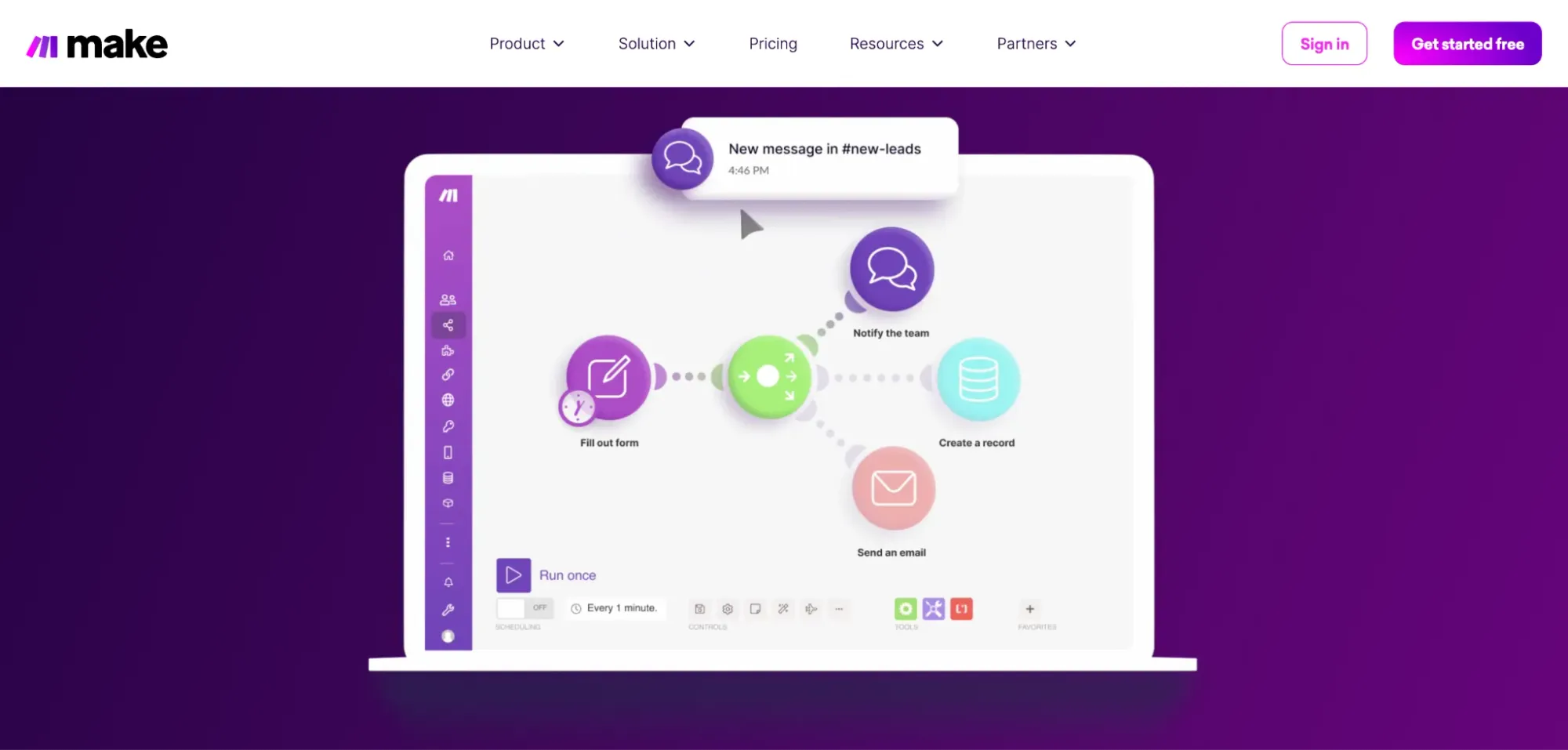
Make, formerly known as Integromat, has evolved significantly over the years, not just in branding but in capability and reach. As an all-in-one automation platform, Make has established itself as a powerhouse, especially for those seeking a more affordable, yet equally robust, alternative to Zapier.
Affordability and Accessibility: Pricing and User Experience
What sets Make apart is its approachable pricing structure and user-friendly experience. For starters, it offers a free plan that allows up to 1,000 operations, a significant leap compared to Zapier’s 100 tasks per month on its free plan. For those needing more, Make’s paid plans begin at a wallet-friendly $9 per month, providing a cost-effective solution without compromising on automation capabilities.
Rich Integration and Automation Capabilities
Boasting support for over 1,000 apps and nearly 6,000 ready-to-use automated flows, Make is a hub for versatility and convenience. Whether you’re a seasoned automation expert or a newcomer, Make’s visual, no-code integration builder makes creating and automating workflows straightforward and efficient. This ease of use extends to more technical users as well, with features like HTTP and JSON modules for those who wish to dive deeper into advanced workflows.
Comparison with Zapier: Where Does Make Stand?
When placed side-by-side with Zapier, several distinctions become apparent:
- Pricing: Make is more affordable, starting at just $9 per month for 10,000 operations, compared to Zapier’s starter plan at $19.99 for 750 tasks.
- Workflow Limitations: Make offers unlimited active scenarios even in its starter plan, while Zapier limits users to only 20 zaps in theirs.
- App Support: Make provides integration for 1,000+ standard apps in its free plan, a bit less than Zapier’s 4,000+, but includes additional capabilities for custom apps and webhooks.
Pros and Cons: Weighing Your Options
Pros of Make:
- More affordable than Zapier, especially for larger volumes of operations.
- Includes a comprehensive no-code workflow builder.
- Offers 1,000+ app integrations and a vast selection of templates.
Cons of Make:
- Fewer app integrations compared to Zapier.
- Can present a steeper learning curve, particularly for more technical features.
In summary, Make emerges as a strong contender in the automation space, particularly for those seeking a cost-effective and user-friendly platform. With its broad range of features and more generous operation limits, Make is well-suited for businesses looking to maximize their automation potential without stretching their budget.
#3. IFTTT
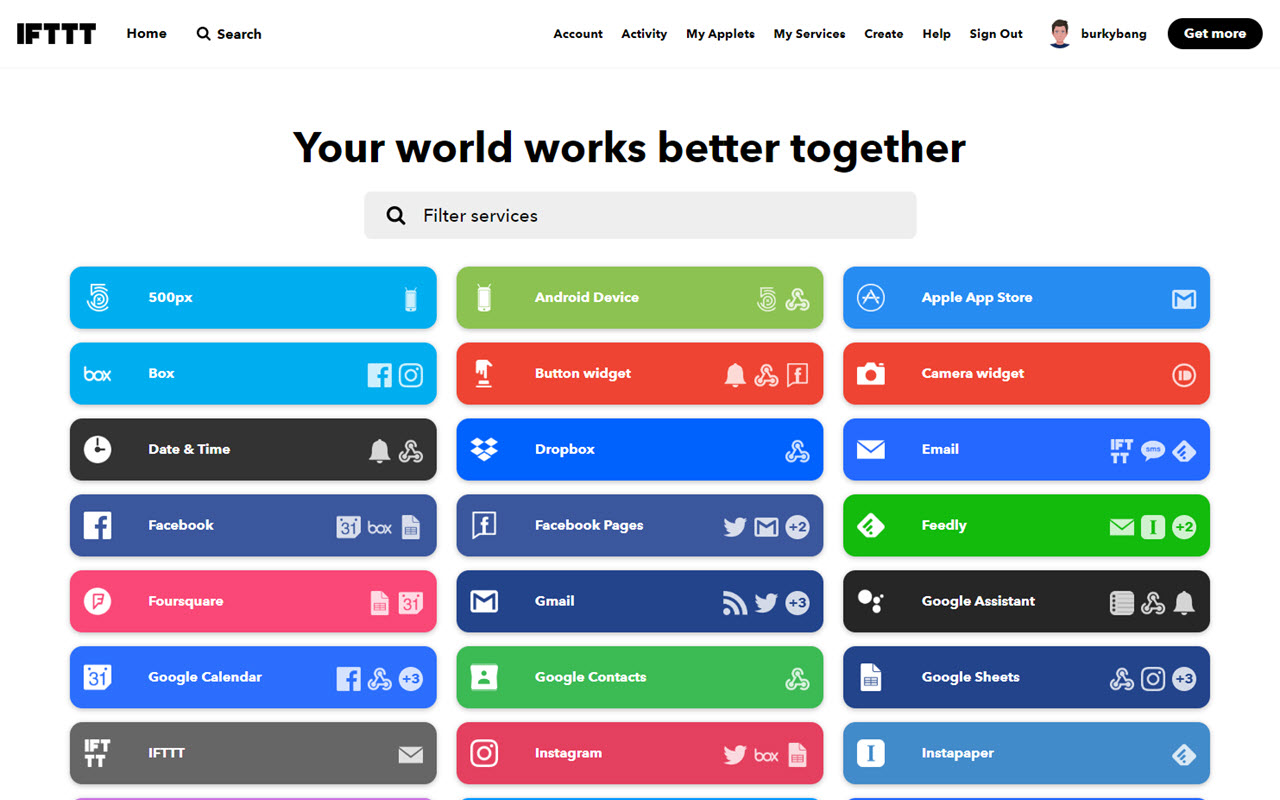
IFTTT, an acronym for “If This Then That,” stands as one of the pioneers in the automation platform arena. Launched in 2011, it remains a robust and versatile choice, especially appealing to the B2C market and smart home enthusiasts.
User-Friendly Interface with Diverse Applications
IFTTT’s strength lies in its simplicity and wide applicability. Whether it’s for personal use or integrating smart home devices, IFTTT offers a seamless experience. Its applets – the equivalent of Zapier’s Zaps – operate on a straightforward “if-then” logic, making them accessible to users of all technical levels. From tracking work hours on Google Calendar to integrating IoT devices like Ring and Philips Hue, IFTTT’s range of over one billion monthly applets caters to an extensive variety of needs.
Plans and Pricing: A Cost-Effective Alternative
Where IFTTT really stands out is in its pricing structure. It offers a free plan, allowing a limited number of applets with unlimited runs. For those needing more, IFTTT’s Pro and Pro+ plans are attractively priced at $2.50 and $5 per month, respectively. These plans offer additional applets, customer support, and developer tools. In comparison to Zapier, which starts at $19.99 per month, IFTTT is a more budget-friendly option, especially for those looking to automate their personal or home-related tasks.
Pros and Cons: IFTTT vs. Zapier
Pros of IFTTT:
- More affordable, with a free plan and lower-cost paid plans.
- Ideal for IoT applications and smart home integrations.
- Simple and quick to set up, offering a user-friendly experience.
Cons of IFTTT:
- Limited in terms of complex, multistep workflows.
- Creating custom applets can be less straightforward than Zapier’s custom Zaps.
- Fewer app integrations compared to Zapier, focusing more on B2C applications.
Embracing a World of Connected Services
IFTTT excels in creating a standard, low-code way for diverse apps and services to communicate, simplifying life and work. It connects over 700 services, including apps, business tools, and even physical appliances, making it a versatile platform. The IFTTT app, available on both the App Store and Google Play, ensures you can manage your automations on the go.
In summary, IFTTT is a fantastic choice for those seeking an affordable, easy-to-use platform for personal, home automation, or basic business tasks. While it may not match the complexity of Zapier’s workflows, its straightforward approach and cost-effectiveness make it a worthy contender in the automation space.
#4. Integrately
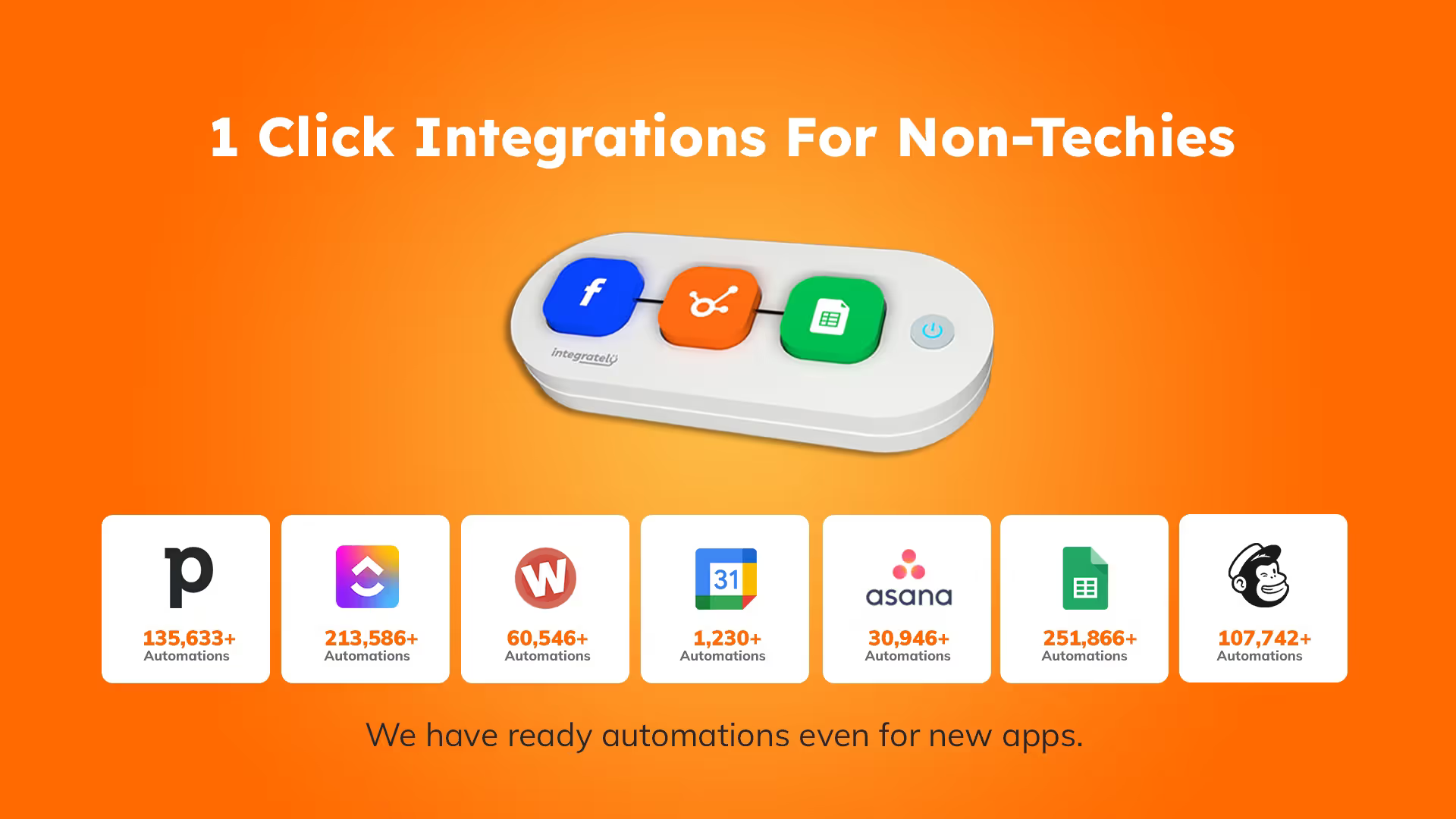
Integrately has quickly become a heavyweight in the automation platform arena, boasting over 8 million ready-to-use automations across 700+ apps. What sets Integrately apart is its extensive library of pre-made workflows and a user-friendly interface, making it an attractive option for those seeking simplicity and efficiency.
Affordable Pricing with Extensive Task Support
In terms of pricing, Integrately stands out for its value. The starter plan is priced at $19.99 per month, similar to Zapier, but offers a significantly higher number of tasks – over 14,000 compared to Zapier’s 750 tasks at the same price point. This makes Integrately a cost-effective choice for businesses looking to maximize their automation capabilities without increasing expenses.
User Experience and Workflow Integration
The platform shines with its ‘Smart Connect’ feature, which facilitates automatic app connections, saving valuable time in workflow setup. Additionally, the dashboard is neatly segmented into categories like project management and website builders, making navigation and operation intuitive and straightforward.
Comparison with Zapier: Key Differences
When comparing Integrately with Zapier, several key differences emerge:
- Pricing: Both start at $19.99 per month, but Integrately offers a higher task limit.
- Number of Flows: Integrately allows up to 20 automations, similar to Zapier’s 20 zaps limit.
- App Support: Integrately supports 700+ apps with one-click integration recipes, while Zapier offers a wider range of over 4,000 apps.
- Custom Workflows: Integrately provides custom webhooks and branching options, whereas Zapier has certain restrictions on custom logic in its starter plan.
Pros and Cons: Evaluating Integrately
Pros:
- More tasks at a similar price point compared to Zapier.
- User-friendly with an extensive library of ready-made automations.
- Simplified sharing of automations with colleagues or clients.
Cons:
- Less technically advanced, potentially limiting complex automation flows.
- Fewer app integrations compared to Zapier’s extensive range.
In summary, Integrately offers a user-friendly, no-code automation experience with a focus on ease of use and cost-effectiveness. While it may not cater to highly complex workflows like some of its competitors, its robust set of ready-made automations and competitive pricing make it a viable choice for businesses looking to automate processes efficiently.
#5. Microsoft Power Automate
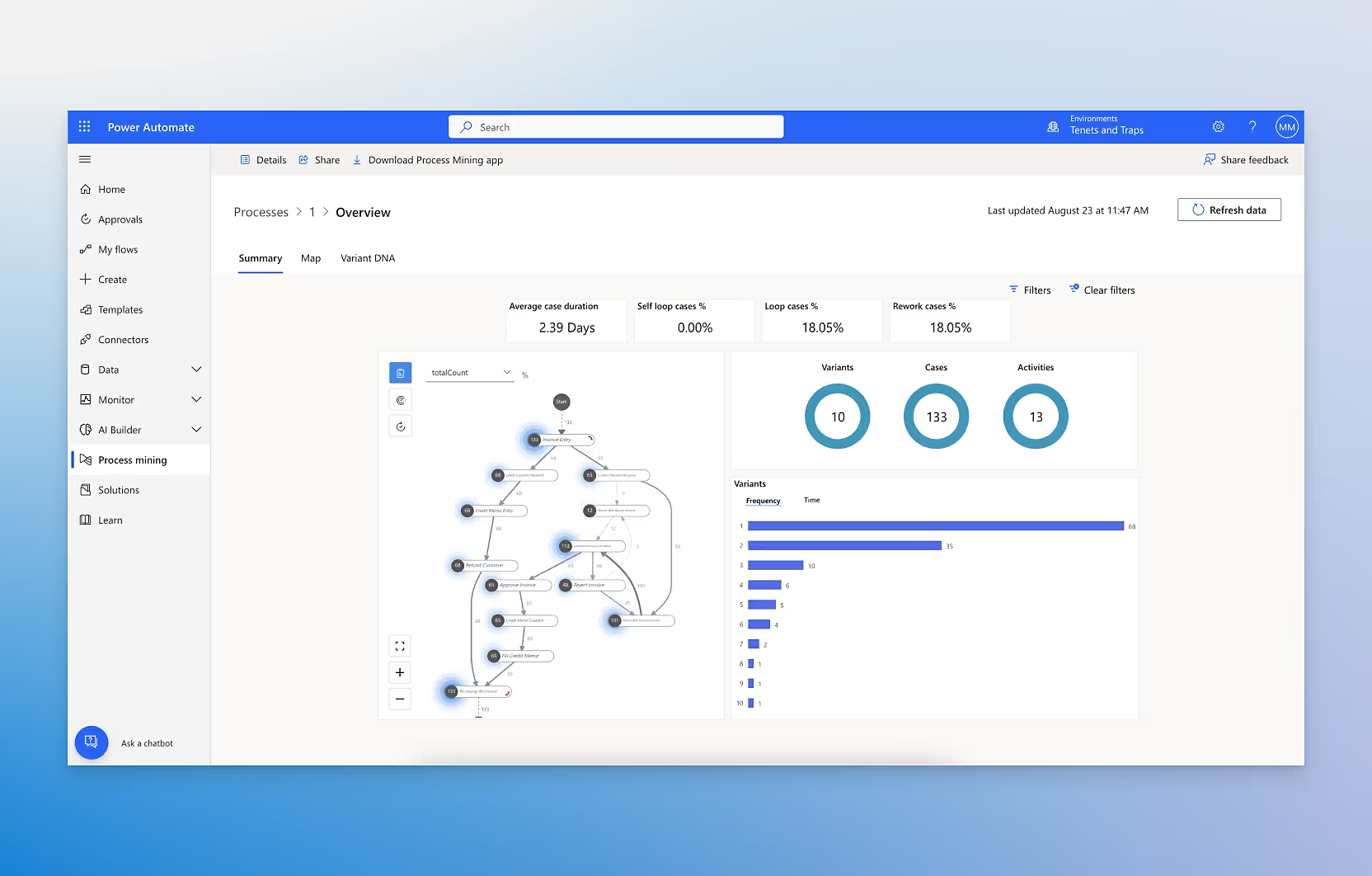
Microsoft Power Automate, often compared to IFTTT, stands out as Microsoft’s answer to advanced automation needs. It’s designed to streamline a variety of tasks, particularly for enterprise-level operations, by combining digital, robotic, and business process automation with a layer of AI.
Integrating AI for Enhanced Automation
One of the highlights of Power Automate is its AI-powered automation builder. This feature not only suggests processes for automation but also guides on how to execute them efficiently. Its integration with Microsoft’s AI Builder enhances its capability to automate complex tasks, ranging from document processing to image and text detection, using pre-trained AI models.
Seamless Integration with Microsoft Suite and Beyond
Power Automate offers native integration with Microsoft Office suites, facilitating effortless data management and collection. The inbuilt process advisor identifies bottlenecks, paving the way for higher efficiency. Although it aligns closely with Microsoft products, Power Automate isn’t limited to them. It supports automation across thousands of apps, providing flexibility in connecting with a variety of services beyond the Microsoft ecosystem.
Pricing and Comparison with Zapier
When it comes to pricing, Microsoft Power Automate presents a competitive edge:
- Pricing: Starts at $15 per user per month, which is lower than Zapier’s starting plan of $19.99 for 750 tasks.
- Number of Flows: Offers unlimited cloud flows compared to Zapier’s limit of 20 zaps in its starter plan.
- App Support: Supports a vast array of apps, potentially more aligned with enterprise needs than Zapier’s 4,000+ standard apps.
Pros and Cons: Evaluating Microsoft Power Automate
Pros:
- More affordable with a per-user subscription model.
- AI-powered tools for creating custom flows.
- Extensive native integration with Microsoft Office Suite.
Cons:
- May not be as user-friendly for beginners compared to other platforms.
- Higher learning curve, especially for non-Microsoft users.
In conclusion, Microsoft Power Automate is a robust choice for those deeply integrated into the Microsoft ecosystem, offering advanced features at a competitive price. While it may require a bit of a learning curve, its capabilities in automating complex business processes make it a strong contender against Zapier, particularly for larger organizations or those seeking enterprise-level solutions.
#6. Pabbly Connect
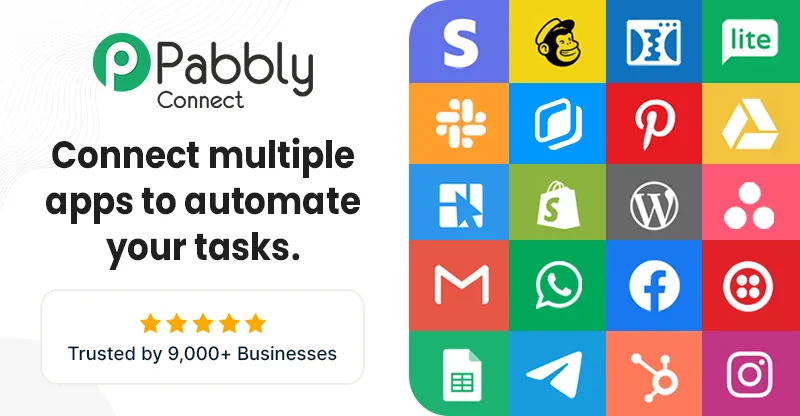
Pabbly stands out with over 800 integrations and the unique offering of free internal tasks and triggers, which makes it thrice as efficient as many other platforms. These internal tasks cover essentials like text formatting, scheduling, data forwarding, and more, offering a wide array of use cases for businesses of all sizes.
Pricing and Comparison with Zapier
Pabbly Connect’s pricing model is particularly appealing:
- Pricing: Offers a monthly plan of $19 for 12,000 tasks, along with a lifetime deal option. This is in stark contrast to Zapier’s $19.99 plan for just 750 tasks.
- Number of Flows: Allows for unlimited automation compared to Zapier’s 20 zaps limit.
- App Support: Supports 800+ apps, including custom API support, which is less than Zapier’s 4,000+ apps but includes instant webhooks.
Pros and Cons: Weighing Up Pabbly Connect
Pros of Pabbly Connect:
- Generous free plan and an attractive lifetime deal, offering more value for money.
- Supports unlimited team members, a feature restricted to higher-tier plans in Zapier.
- Offers advanced features like workflow scheduler and API connection even in free plans.
Cons of Pabbly Connect:
- Fewer app integrations compared to Zapier.
- No live chat support, although it compensates with a large Facebook community and a comprehensive YouTube channel.
User-Friendly Interface with Advanced Capabilities
Pabbly Connect’s interface is straightforward and user-friendly, facilitating highly customizable workflows. It supports a wide range of integrations, from CRM tools to marketing software. The platform allows you to set up multi-step workflows with ease, and its advanced features like scheduling and delays are accessible even on free plans.
In conclusion, Pabbly Connect emerges as a powerful contender in the automation space, particularly for those seeking a cost-effective solution with a rich feature set. While it may have fewer integrations than Zapier, its generous task limits, lifetime deal, and robust internal task management make it an attractive option for businesses aiming to optimize their workflow automation.
#7. Workato
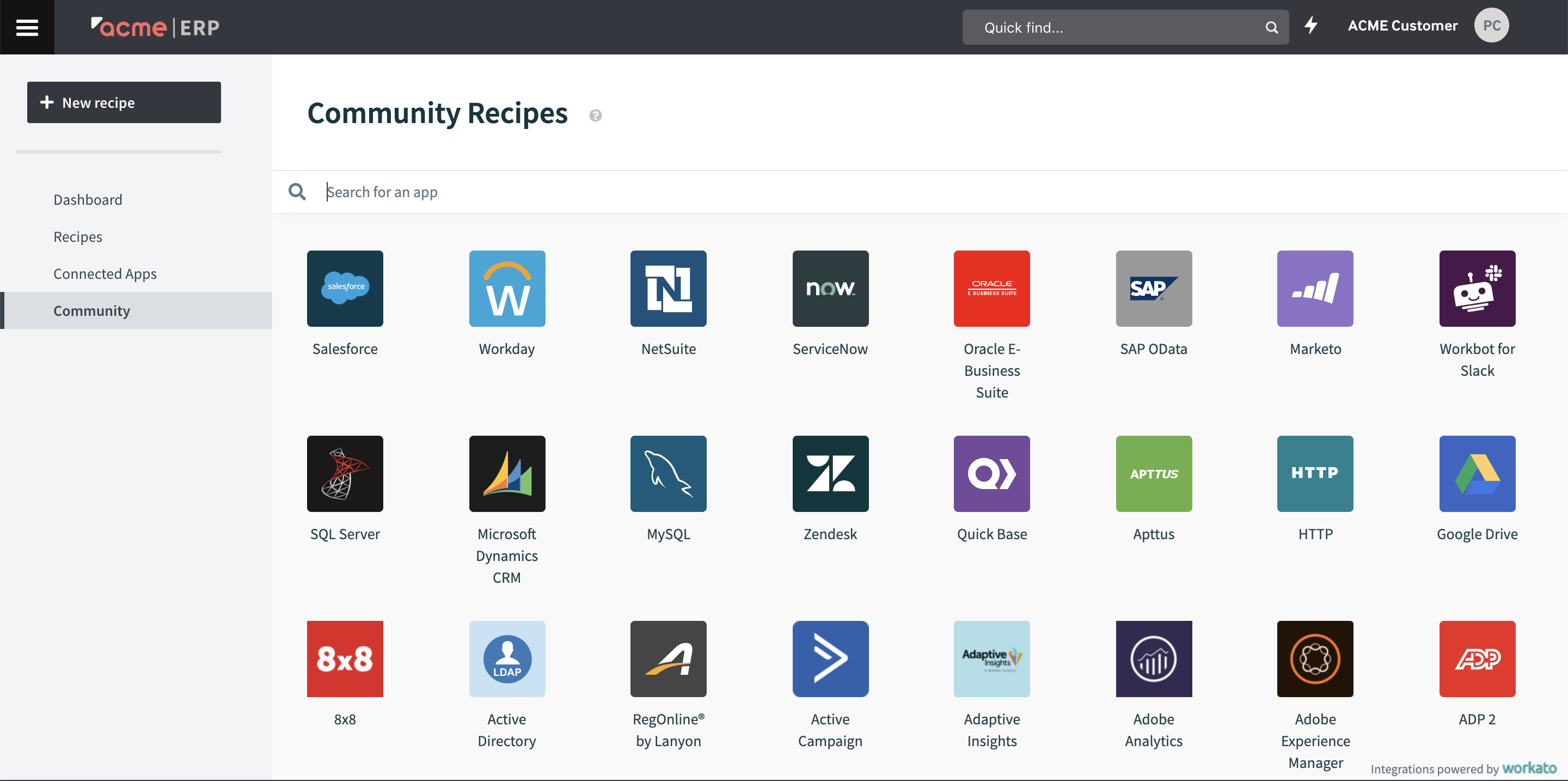
Workato’s strong suit is its capability to manage large-scale, complex workflows, making it an instant favorite for businesses with extensive automation needs. Used by industry giants like HubSpot and Atlassian, it offers dedicated solutions for over 1,000 apps, incorporating Slack-powered automation and workflow automation within an enterprise PaaS framework.
Pricing and Services: A Comparison with Zapier
While Workato adopts an on-demand enterprise pricing model, it contrasts with Zapier’s fixed pricing structure:
- Pricing: Workato provides custom quotes tailored to specific enterprise needs, compared to Zapier’s starting plan of $19.99 for 750 tasks.
- Number of Flows: Workato offers unlimited flows based on requirements, whereas Zapier limits to 20 zaps in its starter plan.
- App Support: Unlimited custom integrations in Workato versus Zapier’s 4,000+ standard apps.
Pros and Cons: Assessing Workato’s Fit
Pros of Workato:
- Tailored for enterprise-grade operations with a focus on security and scalability.
- Supports a vast array of use cases across various departments.
- Over 1,000 app integrations and more than 400,000 pre-built recipes.
Cons of Workato:
- Primarily suitable for company-wide automations, which may not fit smaller-scale needs.
- Some users report a steep learning curve and a need for better documentation.
User Experience and Market Position
Workato has garnered recognition for being exceptionally suited to enterprise needs, streamlining automation across entire organizations. It provides a robust list of connected services, including platforms like SAP, NetSuite, and Asana. The platform requires the purchase of a base workspace, with the option to add more features as needed. It’s advisable to contact Workato’s sales team for a demo and specific pricing details.
In summary, Workato emerges as a top choice for large enterprises seeking a comprehensive, scalable automation solution. While it may present some challenges for beginners, its extensive capabilities and customization options make it a potent tool for streamlining complex, company-wide operations.
#8. Tray.io
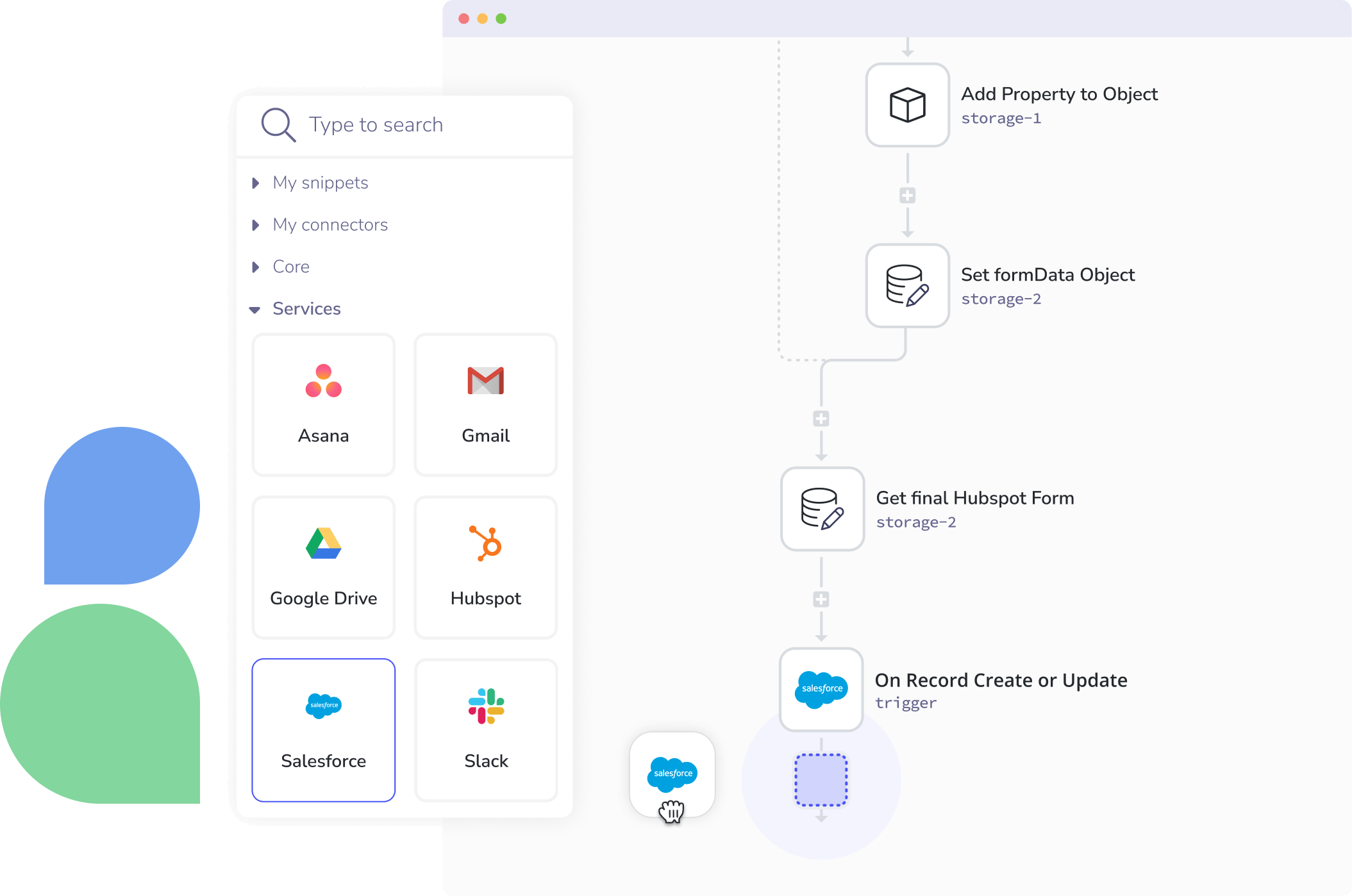
Tray.io positions itself as a comprehensive integration and automation platform, offering sophisticated capabilities beyond basic integrations, particularly for complex business processes.
Advanced Integration and Automation Capabilities
With over 600 app connectors, Tray.io facilitates automation across various operations, not just limited to standard tasks. Its commitment to security and seamless data connections between apps sets it apart, especially for enterprises prioritizing scalability and data transformation.
Sophisticated User Experience with Enhanced Flexibility
Tray.io’s drag-and-drop visual flow builder, coupled with its intricate logic and process flow, allows for the creation of complex automations that maintain data consistency. Its advanced conditional logic, including branching and loop connections, ensures no data field is overlooked, making it a powerful tool for various use cases like account-based marketing, email personalization, and lead management.
Pricing and Services: Comparing Tray.io with Zapier
Tray.io’s pricing is tailored to enterprise needs:
- Pricing: Enterprise-level plans starting at $1000 per month, a significant leap compared to Zapier’s $19.99 plan for 750 tasks.
- Number of Flows: Offers unlimited templates, flows, and users, whereas Zapier limits to 20 zaps.
- App Support: Connects with any app or software using RESTful APIs and custom webhooks, providing more customization than Zapier’s 4,000+ standard apps.
Pros and Cons: Assessing Tray.io’s Fit
Pros of Tray.io:
- Ideal for large-scale, enterprise-level automations.
- User-friendly interface suitable for both coders and non-coders.
- The Universal Connector feature for connecting non-standard web services.
Cons of Tray.io:
- More complex and less user-friendly for end users.
- Custom integration building can be time-consuming.
- Higher pricing point and the need for personalized pricing details.
In summary, Tray.io is an optimal choice for businesses seeking advanced, large-scale automation solutions. Its flexibility, coupled with a user-friendly interface and the ability to connect with a wide range of apps, makes it a strong contender for enterprises. However, its higher price point and complexity might be limiting factors for smaller businesses or those with simpler automation needs.
#9. Outfunnel
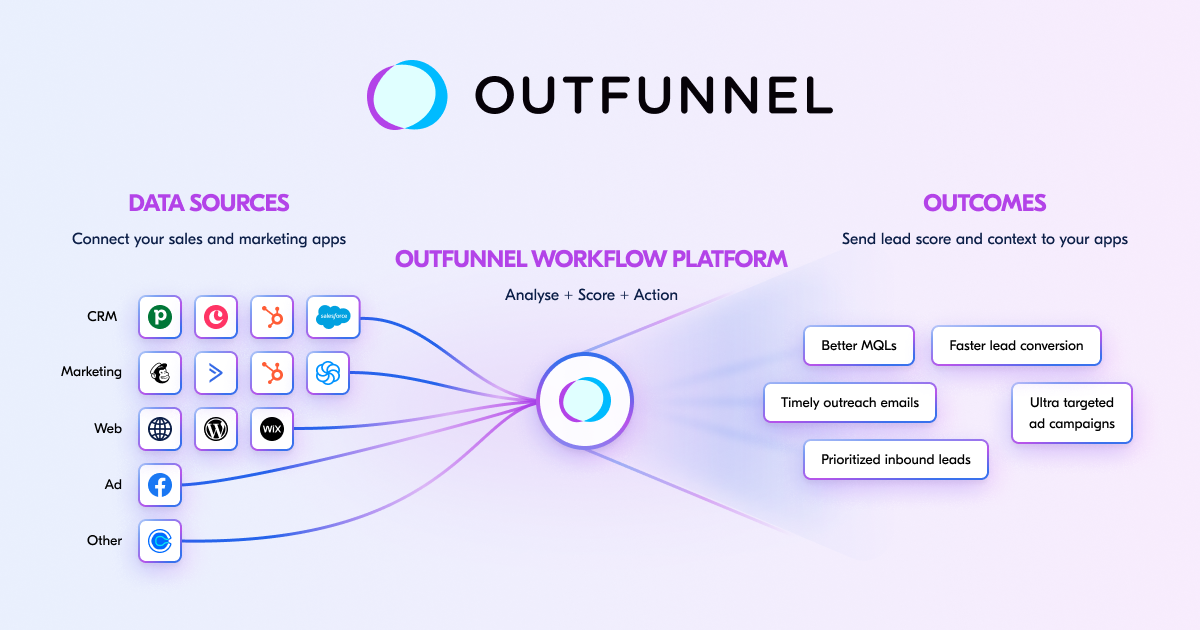
Outfunnel stands out as a dedicated marketing automation tool, specifically designed to seamlessly integrate CRM, marketing, and sales pipelines. Its core strength lies in its ability to maintain synchronicity between CRM and marketing contacts, a crucial aspect for scaling businesses.
Focused Automation for Sales-Marketing Alignment
Outfunnel excels in automating sales, marketing, and growth operations, ensuring data consistency between different departments. This harmonious data sharing between sales and marketing leads to better alignment, making tasks like lead scoring and web tracking more efficient and effective.
Pricing and Functional Comparison with Zapier
Outfunnel’s pricing and offerings present a contrast to Zapier’s broader approach:
- Pricing: The starter plan begins at $19 per month for 2,500 events, slightly undercutting Zapier’s $19.99 for 750 tasks.
- Number of Flows: Provides up to 5 flows in the starter plan, compared to Zapier’s limit of 20 zaps.
- App Support: Hundreds of integrations with major sales and marketing suites, whereas Zapier supports over 4,000 apps.
Pros and Cons: Weighing Outfunnel’s Suitability
Pros of Outfunnel:
- Specialized for sales and marketing tool integration.
- Supports popular platforms like HubSpot, PipeDrive, and Salesforce.
- Features like lead scoring and marketing automation are directly tied to lead generation and revenue.
Cons of Outfunnel:
- Limited in terms of the number of integrations compared to Zapier.
- More focused on sales and marketing, lacking broader application versatility.
Targeted Integration for Enhanced Sales-Marketing Synergy
Outfunnel is an ideal choice for businesses seeking to align their CRM with marketing tools such as Mailchimp and ActiveCampaign. It simplifies the synchronization of sales and marketing contact lists and facilitates the sharing of marketing engagement data with sales teams.
In conclusion, Outfunnel is a formidable Zapier alternative for those whose primary focus is on sales and marketing integrations. While it may not offer the extensive range of integrations that Zapier does, its specialized features and ability to foster sales-marketing synergy make it a valuable tool for specific business needs.
#10. Automate.io
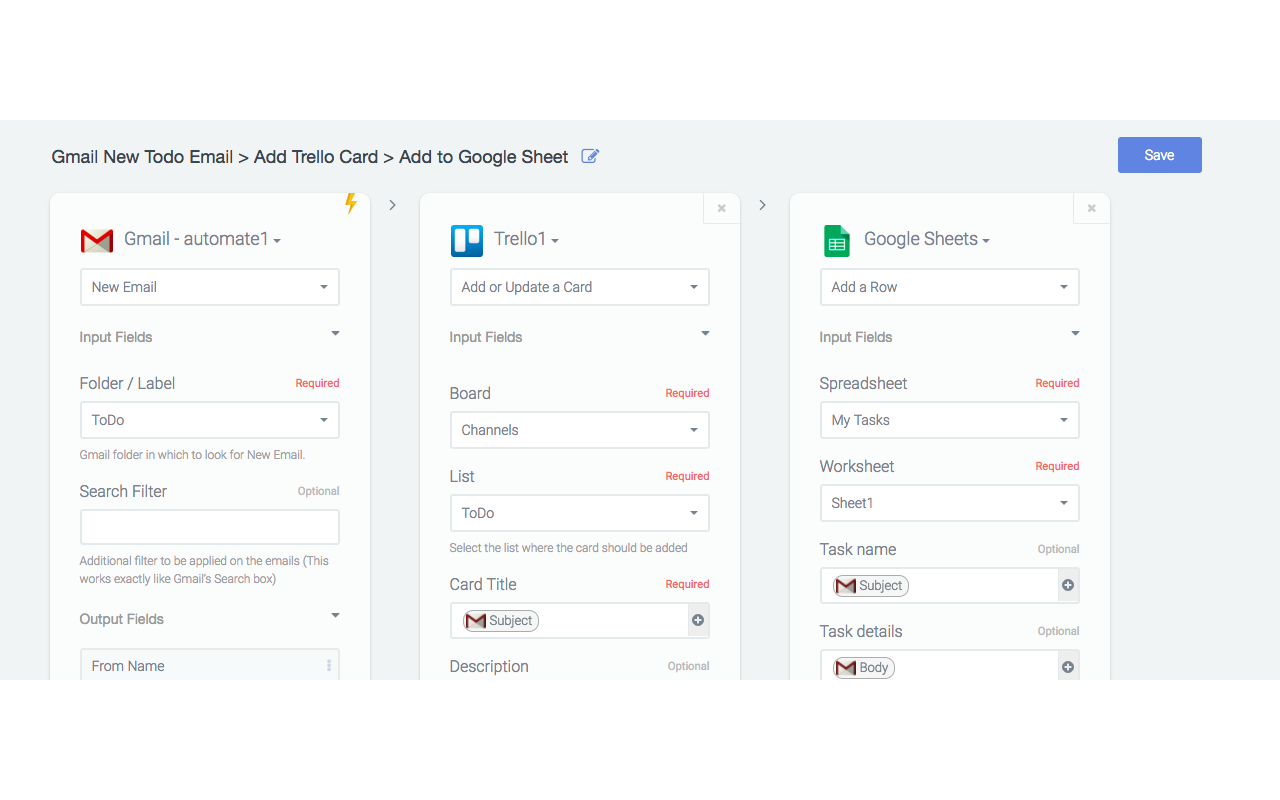
Automate.io positions itself as a modern iPaaS (Integration Platform as a Service) solution, offering straightforward yet powerful automation capabilities. It connects over 200 cloud apps and supports webhooks and Rest APIs for expanded functionality, making it a viable alternative to Zapier for those looking for a simpler framework.
User-Friendly Interface with Robust Integration Options
One of Automate.io’s standout features is its drag-and-drop interface, which simplifies the creation of automation flows. The platform caters to a range of categories, including marketing, CRM, eCommerce, and payments. Its ability to create multi-action bots even in a starter plan is particularly appealing for businesses seeking complex automation solutions without a hefty price tag.
Pricing and Services: A Comparative Look at Automate.io and Zapier
Automate.io offers competitive pricing and features compared to Zapier:
- Pricing: Starts at $9.99/month for 600 tasks, which is more budget-friendly compared to Zapier’s $19.99 for 750 tasks.
- Number of Flows: Both platforms allow up to 20 bots/zaps in their respective starter plans.
- App Support: Automate.io supports 200+ apps, including 1 premium app in the starter plan, while Zapier offers over 4,000 apps.
Pros and Cons: Evaluating Automate.io
Pros of Automate.io:
- User-friendly with a simple drag-and-drop automation flow creator.
- Supports Rest APIs and webhooks for custom integrations.
- Features like retry and API downtime handling minimize workflow execution failures.
Cons of Automate.io:
- Fewer app integrations compared to Zapier, limiting some automation possibilities.
- Custom workflow creation in the starter plan comes with certain limitations.
Targeted Integration and Collaboration Features
Automate.io is especially beneficial for teams that require collaboration in automation creation. The platform’s focus on data security, coupled with its collaborative features, ensures that teams can work together efficiently while maintaining data integrity.
In summary, Automate.io emerges as a strong contender for businesses seeking a simple yet effective automation tool. Its competitive pricing and user-friendly interface make it an attractive alternative to Zapier, particularly for small to medium-sized businesses or those starting their journey in automation.
Conclusion
And there you have it – a diverse array of Zapier alternatives, each with its unique strengths and offerings. Whether you’re a small startup, a growing business, or a large enterprise, there’s a tool out there that can fit your specific automation needs without stretching your budget. From Nanonets’ cost-effective automation and Make’s user-friendly interface to the enterprise-level capabilities of Workato and the sales-marketing alignment of Outfunnel, the options are plentiful and varied.
Remember, the key to choosing the right tool lies in understanding your specific requirements. Do you need a platform with a broad range of integrations like Zapier, or are you looking for something more specialized? Is budget your primary concern, or are you seeking advanced features like AI-powered automation or enterprise-grade security? Each alternative we’ve explored offers its unique blend of features, pricing, and usability.
In the end, the right tool is the one that aligns seamlessly with your workflow, enhances your productivity, and fits within your financial framework. Automation is about making life simpler, not more complicated. So, take your time, weigh your options, and choose the tool that turns the gears of your business smoothly and efficiently.
Happy Automating!


